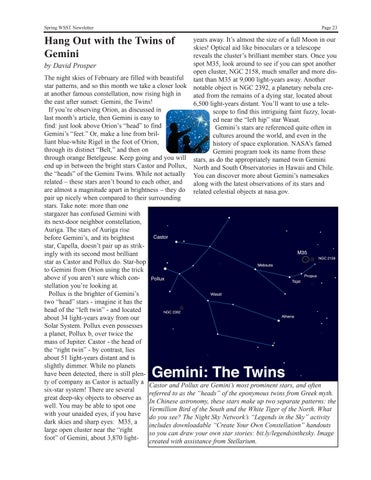Spring WSST Newsletter
Hang Out with the Twins of Gemini
Page 23
years away. It’s almost the size of a full Moon in our skies! Optical aid like binoculars or a telescope reveals the cluster’s brilliant member stars. Once you spot M35, look around to see if you can spot another by David Prosper open cluster, NGC 2158, much smaller and more disThe night skies of February are filled with beautiful tant than M35 at 9,000 light-years away. Another star patterns, and so this month we take a closer look notable object is NGC 2392, a planetary nebula creat another famous constellation, now rising high in ated from the remains of a dying star, located about the east after sunset: Gemini, the Twins! 6,500 light-years distant. You’ll want to use a teleIf you’re observing Orion, as discussed in scope to find this intriguing faint fuzzy, locatlast month’s article, then Gemini is easy to ed near the “left hip” star Wasat. find: just look above Orion’s “head” to find Gemini’s stars are referenced quite often in Gemini’s “feet.” Or, make a line from brilcultures around the world, and even in the liant blue-white Rigel in the foot of Orion, history of space exploration. NASA’s famed through its distinct “Belt,” and then on Gemini program took its name from these through orange Betelgeuse. Keep going and you will stars, as do the appropriately named twin Gemini end up in between the bright stars Castor and Pollux, North and South Observatories in Hawaii and Chile. the “heads” of the Gemini Twins. While not actually You can discover more about Gemini’s namesakes related – these stars aren’t bound to each other, and along with the latest observations of its stars and are almost a magnitude apart in brightness – they do related celestial objects at nasa.gov. pair up nicely when compared to their surrounding stars. Take note: more than one stargazer has confused Gemini with its next-door neighbor constellation, Auriga. The stars of Auriga rise before Gemini’s, and its brightest star, Capella, doesn’t pair up as strikingly with its second most brilliant star as Castor and Pollux do. Star-hop to Gemini from Orion using the trick above if you aren’t sure which constellation you’re looking at. Pollux is the brighter of Gemini’s two “head” stars - imagine it has the head of the “left twin” - and located about 34 light-years away from our Solar System. Pollux even possesses a planet, Pollux b, over twice the mass of Jupiter. Castor - the head of the “right twin” - by contrast, lies about 51 light-years distant and is slightly dimmer. While no planets have been detected, there is still plenty of company as Castor is actually a Castor and Pollux are Gemini’s most prominent stars, and often six-star system! There are several referred to as the “heads” of the eponymous twins from Greek myth. great deep-sky objects to observe as In Chinese astronomy, these stars make up two separate patterns: the well. You may be able to spot one Vermillion Bird of the South and the White Tiger of the North. What with your unaided eyes, if you have do you see? The Night Sky Network’s “Legends in the Sky” activity dark skies and sharp eyes: M35, a includes downloadable “Create Your Own Constellation” handouts large open cluster near the “right so you can draw your own star stories: bit.ly/legendsinthesky. Image foot” of Gemini, about 3,870 lightcreated with assistance from Stellarium.





